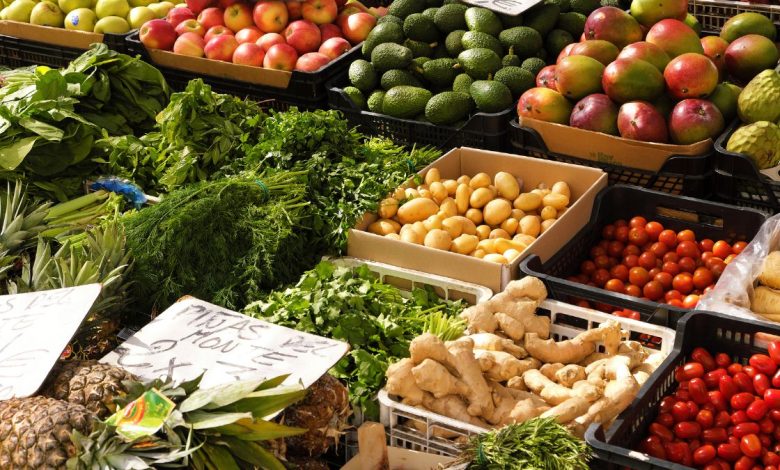August Food Basket Drops Slightly: See Which Prices Fell

The August Food Basket Drops slightly, offering some relief to South African households. However, affordability remains a serious challenge for low-income families. According to the Household Affordability Index compiled by the Pietermaritzburg Economic Justice and Dignity Group (PMBEJD), the average food basket cost fell by 1.1% month-on-month in August 2025.
This decline, although welcome, does not erase the fact that nutritious food remains out of reach for millions. Below, we break down which food prices decreased, which rose, and what this means for families across the country.
What Is the Household Food Basket?
The basket tracks the prices of 44 essential food items. Surveys are done in Johannesburg, Durban, Cape Town, Pietermaritzburg, Mtubatuba, and Springbok. Data is collected from 47 supermarkets and 32 butcheries.
August Food Basket Cost Overview
In August, the average household food basket cost R5 380.62, down by R62.10 (-1.1%) compared to July. Yet, the basket was R153.48 (2.9%) more expensive year-on-year.
Read more about innovation in retail in our article: Checkers Launches SA’s First Smart Trolley with Built-in Scanner & Automated Checkout.
Price Changes in August
The table below shows which food items decreased and which increased in August.
| Category | Food Items | Price Change |
|---|---|---|
| Decreased (≥5%) | Potatoes (-9%), Onions (-15%), Tomatoes (-12%), Carrots (-16%), Spinach (-6%), Cabbage (-6%), Bananas (-6%), Wors (-5%) | -5% to -16% |
| Decreased (2%–5%) | Rice (-4%), Sugar beans (-2%), Cremora (-3%), Oranges (-4%), Brown bread (-2%) | -2% to -4% |
| Increased (≥5%) | Soup (+5%), Beef tripe (+6%), Peanut butter (+6%) | +5% to +6% |
| Increased (2%–5%) | Samp (+2%), Stock cubes (+2%), Full cream milk (+3%), Chicken feet (+3%), Beef liver (+3%), Butternut (+3%), Green pepper (+4%), Polony (+4%) | +2% to +4% |
Regional Food Basket Trends
The basket did not cost the same everywhere. Regional differences showed varied impacts:
- Cheaper in: Johannesburg (-R108.44), Durban (-R105.01), Cape Town (-R59.76), Mtubatuba (-R96.68)
- More expensive in: Pietermaritzburg (+R69.93), Springbok (+R27.62)
Learn how banking meets retail in the new Absa and Shoprite Partner for Exciting New Cash-Back Rewards Program.
Wages vs. Food Basket Costs
The National Minimum Wage in August was R28.79 per hour, equating to R4 836.72 per month for 21 working days.
However, electricity and transport consumed 59.2% (R2 681.85) of that income, leaving just R1 974.87 for food and other expenses. This amount is 46.6% below what is needed to cover a basic, nutritious food basket for a family of four.
Food Poverty and Nutrition
The Food Poverty Line is R796 per person per month. But in August, workers supporting families of four could only allocate R493.72 per person to food, far below the poverty threshold.
Child Nutrition Costs
Feeding a child a basic, nutritious diet cost R943.13 in August, R14.28 less than in July. However, the Child Support Grant (R560) was still 30% below the food poverty line and 41% below the actual cost of feeding a child.
Expert Commentary
Mervyn Abrahams, Programme Coordinator at PMBEJD, highlighted the affordability crisis:
“If the entire R1 974.87 all went to buy food for a family of four, it would provide R493.72 per person per month, again far below the food poverty line of R796 per person per month.”
Long-Term Concerns
While the August Food Basket drops slightly, the relief is temporary. Essential proteins remain costly, and wage constraints mean most low-income households cannot meet nutritional needs.
Discover how a leading supermarket is reshaping shopping in South Africa: Top SA Retailer Expands Stores with Exciting New Concept.
The August Food Basket Drops offer small relief, but affordability remains a pressing issue. Lower vegetable prices helped households stretch budgets slightly, yet the cost of proteins and staple goods continues to rise.
For millions of South Africans, wages and social grants remain inadequate. Without structural interventions, the gap between income and the cost of nutrition will only widen.



